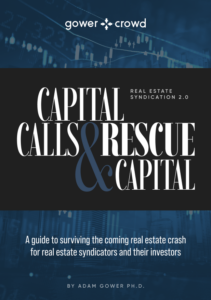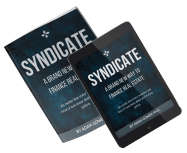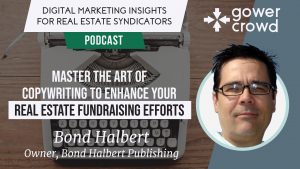Podcast Episode 312: Steve Herman, White House Bureau Chief, VOA
The Incredible Feedback Loop of Twitter

Steve is a veteran news reporter and broadcast foreign correspondent who has served as a bureau chief for the VOA in India, South Korea and Thailand before returning to Washington where he is now White House bureau chief.
A prolific Twitter user, Steve was a Shorty Awards finalist for Best Journalist in Social Media.
Steve has 80,000+ followers on Twitter, and has tweeted over 100,000 times.
Having done on-the-ground reporting from combat zones, civil uprisings and areas struck by major natural disasters, you can now watch his ultimate challenge recorded live, as he appears on the GowerCrowd podcast.
See below for more links to Steve.
What You're Going to Learn
* The changing face of mass communication
* Monitoring real estate syndication on Twitter
* How to use lists on Twitter
* Finding influencers
* Why you should follow followers
* Using #hashtags like a pro
* The quick and easy way to be relevant
* Why you need a pinned tweet
* What works best on Twitter
* Determining optimal number of tweets per day
* How to find HNW twitter users
* Why you need a good follower/following balance
And much, much more.
Listen To or Watch the Full Podcast Here
Show Highlights
The Changing Face of Mass Communication
Adam Gower: Today, we're going to talk about Twitter, but tell me what you've seen throughout your career - the way that mass communication has evolved over the years to where it is now, to Twitter, and how it differs today.
Steve Herman: Well, what we have now, Adam, is this incredible instantaneous feedback loop. Something gets on Twitter like a presidential tweet, within 30 seconds, it's on the cable-TV networks, and then people are tweeting about what they've just seen on the TV network about the tweets.
In the old days, I can tell you, talking to some of the foreign correspondents who came not too far in the past before me, because of the time difference, they would go down to the post office, send their story by Telex. At 6:00, were unreachable because of the difficulty of international communications, and would then proceed to get very smashed in a bar with other competitors, and go to work the next day, perhaps at 10:00 a.m., with a hangover, and put in eight hours or day or so, and rinse and repeat. Now, because of this 24/7 news cycle [cross talk]
Adam Gower: They're in the bar all the time.
Steve Herman: Right. You're just in touch with your editors around the clock. They could reach you anywhere, and you have to stay very sober.
The Quick and Easy Way to Be Relevant
Adam Gower: I've also noticed a technique that you use that's very interesting, that I've adopted, but I don't really know why I've adopted it. Let me ask you, I've noticed that you will see, for example, an interesting article, something relevant, and then retweet it with just a hashtag, like #Finland. Somebody wrote an article, but they didn't put the ... Explain the logic behind that to me a little bit.
Steve Herman: Right. Well, it's a quick and easy way to retweet that information. Basically what I'm saying is, "Here's what this is about." Frankly, sometimes, I'm in such a rush, I just feel it's important; I'm I'm focused on something else, but I think it's important for my followers to see, so I'll just retweet it with the hashtag. It's nothing more than that.
Other times, it maybe something that's quite controversial, and I don't give opinion on my tweets, because I am a broadcast journalist, who is putting information out in an objective, and analytical manner. I'm not an opinion writer; I'm not an opinion columnist; I'm not an activist; I'm not a partisan journalist.
A lot of times, people will retweet something, and put their own particular spin on it. I may, if I have time, give some context, a little bit of history about why this is important.
I frequently do that with the president's tweets, where I'll explain, "This is the 23rd time that the president has used the phrase 'enemy of the people,' or I may just put it out there with a hashtag, saying #media@POTUS. It all really depends on the circumstances.
Why You Need a Pinned Tweet
Adam Gower: Explain the pinned tweet, and how that actually can be used for [cross talk]
Steve Herman: The pinned tweet will always be at the top of your Twitter feed, of what people see on your Twitter feed. Even if you've tweeted something six days ago, or three minutes ago, above that will be the pinned tweet.
Some people will use it as their manifesto. You have in your Twitter profile some space to explain who you are, but sometimes people want to use the pinned tweet to explain a little bit more about who they are, or what they're tweeting about.
That is going to be your most prominent tweet, and when people just come across your Twitter feed, that's the one they're most likely to see first, at the top. Some people don't use pinned tweets at all. I'm keeping that one up there until I come up with something better.
Adam Gower: The 200,000th tweet.
Steve Herman: Well, I'll probably change it before I get to 200,000.
What Works Best on Twitter
Adam Gower: Have you noticed any particular difference in terms of the kind of interaction you get between video, and repeating somebody else's article, or writing your own stuff, or et cetera? >What works best on Twitter?
Steve Herman: Certainly, you do get a lot more engagement with video. There's no doubt about it. I will put out a short video clip that may be something very innocuous, but because it's happening at the White House, and showing something a bit unusual, it will get a lot of views, and a lot of engagement, just because it's something a little bit different.
If you can put a video, if it's relevant, into your tweet, or even a photograph, it will get more engagement than just some text. Obviously, having a link is even better than just plain text. You're linking to something else on the web to give people more information about what you're tweeting about.
The Holy Grail, I guess, is having them all - having a link, and some video, or a photograph - on your tweet, and you will see that it will perform better than usual.
Determining Optimal Number of Tweets Per Day
Adam Gower: What about the number of tweets per day?
Steve Herman: That varies. I sometimes will go well above 100, because I may be live-tweeting an event, a presidential news conference, or on the scene of a disaster; giving a blow-by-blow of what's happening.
I do think that quality is more important than quantity when it comes to tweeting. People might not want to follow you if you're tweeting every three minutes, and they don't find the content very valuable.
You need to find a sweet spot for what works for your particular account. Some people that are very influential on Twitter are not tweeting all that much, but when they do tweet, it's something that their followers are really hanging on to.
Related article: The Best Social Media Platforms for Finding Real Estate Investors
Why You Need a Good Follower/Following Balance
Steve Herman: I'm very disciplined. Another thing we should mention, Adam, is I don't ... Although I may have more than 83,000 followers, I don't want to follow 83,000 people. It would just make looking at my timeline practically useless, and I would have to go to lists.
I'm very disciplined. I try to keep my number of followers under 2,000, because I'm looking for what is the major breaking news, both in the United States, and around the world in my Twitter feed. I don't want to miss anything big. If I'm following 28 comedians, and 96 corn farmers, and 103 politicians in the state of Minnesota, because I needed to follow them once, on a particular day ... I may follow someone for a particular period, brief period of time, and then not follow them anymore.
Adam Gower: You actually physically go in, and unfollow, do you, once you ...?
Steve Herman: I unfollow them. It's nothing personal [cross talk]
Adam Gower: -just practical, right.
Steve Herman: -I could put them on a list. A lot of people that I have on the different lists, I'm not following, and I can go in, and just use that list for something in particular. Lists are great for subject-matter following.
Using Direct Messaging on Twitter
Adam Gower: Do you message people on Twitter that ... Do you find that people are responsive particularly?
Steve Herman: Yes. I seek interviews and quotes via direct messaging all the time. A lot of people, you can only message them if they're following you. If you're both following each other, then you've ... Then, it's like an instant-messaging platform.
You have to be careful, because there have been people who've accidentally put on their Twitter feed some direct messages, and there have been some consequences for that. That can especially happen when you're trying to use the cell phones, and text messaging to answer somebody on Twitter, so be careful about that. Direct messaging is a great way to contact people. Some people are open to receiving direct messages from anyone.
Adam Gower: Oh I see. You can set ... You can make your settings [cross talk].
Steve Herman: Yes, that's one of the options you have in your Twitter set-up.
Adam Gower: Do you use your phone ...? At what proportion do use your phone, and your desktop?
Steve Herman: Well, it depends on where I'm sitting when I'm in a stationary position, like here at the White House. Then, I'm using the laptop, but I also, when I'm outside, I'm tweeting. Then, I have a third screen here to just monitor particular feeds, as well. If you look on my pinned tweet, it'll show you the three different devices sometimes I'm using simultaneously.
Adam Gower: That's how you get a hundred out at once.
Steve Herman: I'm a bit obsessed. I'm not a normal person.
Monitoring Real Estate Syndication on Twitter
Adam Gower: What is it about Twitter that makes it important? What are the key things that you need to be doing to be effective on Twitter?
Steve Herman: Well, I think you have to go into Twitter with a goal in mind, or else it is a bit nebulous. When I first got on Twitter, I initially was just using it as a monitoring device. I got interested in it ...
I was in India when there was a terrorist attack on the hotels in Bombay, Mumbai. The information that was coming out of the Indian cable TV news networks was unreliable. At first, it was blamed on Nigerian gangs. The most accurate, instantaneous information that was coming about the attacks was from people sitting in the hotel restaurants on their BlackBerries, back then, getting on Twitter - firsthand eyewitness accounts.
That really opened my eyes to Twitter as a valuable device for finding what's going on in real time. Up until that point, I was very skeptical about it, because anybody can have a Twitter account, and can tweet anything.
Yes, you do need to be very careful. There are a lot of people out there, obviously, putting out erroneous, unconfirmed information, trying intentionally to mislead people, but I think that is a distinct minority. Of course, you've got verified accounts on Twitter, so you know that someone is who they say they are.
To me, I was initially just planning to use it like the modern-day version of a police scanner radio, where you're listening for information that would help me with my job, as sort of a tip thing, where I could then find out possibly what's going on, and try to get it verified from outside sources.
I had no intention, when I got on Twitter, of really being a person who is active, tweeting, himself. Gradually, I took the dip, and started to gain a following, because of the niche that I had, in Asia, of putting out real-time information about what was going on in the region, and not trying to put any particular spin on it.
As I said, first, you have to decide what is your goal with Twitter. You can be a lurker on Twitter, and just follow people, and pick up information, or you can try to build your own presence. Building your brand is a big thing these days. If you're trying to get prominent in a particular field, and network, then it's important to put your voice out there, as well.
How to Use Lists on Twitter
Adam Gower: What tools are there on Twitter that one can use in order to monitor the industry and - hint - lists? If there's anything else to talk about ... Remember, a lot of people including self are novice, basically, interns are using these tools in comparison to you ... What devices, or tools can we use on Twitter to [cross talk]
Steve Herman: Well, you can build lists. You can build a list of certain people that you want to follow who are engaged in, perhaps, tweeting out information, tips, gossip, discussion of a particular topic, such as real-estate investing. A lot of people are also interested in real-time financial information.
You don't need to subscribe to the Bloomberg terminal necessarily. You can follow a lot of news accounts. You can follow Bloomberg on Twitter. You can follow Reuters. There are a lot of financial commentators out there giving real-time analysis. You can build these individual lists, and follow a particular list at a particular time, or you can just have in your timeline all of your followers.
Now, obviously, I'm focused on real-time news, but there are other types of people that I follow, as well. Twitter can even provide Adam some comic relief from time to time. There are some very funny people on Twitter - I'm not one of them - who can give you a good laugh to break up what can be a very dark day, sometimes.
Finding Influencers on Twitter
Adam Gower: How do you search for relevant followers? One thing that I've been trying to figure out recently is influencers. I've actually been talking to a lot of influencer agencies. Interestingly, there are none that specialize - that I can find - in high-net-worth- identifying, and speaking to high-net-worth individuals, which is the audience that we're looking for basically. How does one set about identifying important influencers on Twitter? What would be the best way of going about that, do you think?
Steve Herman: Well, I think the key would be to search for certain words. Look at their accounts; see how many followers they have; see what their ratio is. There are some people with 50,000 followers, but they're also following 50,000 people.
That, to me, does not necessarily denote someone who is an influencer on Twitter, because they've mainly gotten people to follow them back that they're following, as well. If someone has 300,000 followers, and they're only following 1,000 people, that's a pretty good indication that they're an influencer.
Then you have to look at their timeline. Scroll down their timeline. Is what you see on that timeline valuable to you? Is it insightful, or is it ahead of the curve, compared to what other people are tweeting, or what you've read in the newspaper this morning? Does it appear to be credible?
There's a lot of people with large followings that are sensationalistic, and titillating, but it doesn't mean, necessarily, that they're authoritative, or accurate in what they're putting out there. Katy Perry is one of the top accounts on Twitter, but unless you're into her music, it's probably not one that you really would care to follow.
Some of the most influential accounts for a particular niche might only have a couple thousand of followers, just because that that niche is so narrow. Just because someone has hundreds of thousands, or a million followers doesn't mean it's necessarily an account that you need to follow.
Using #Hashtags Like a Pro
Adam Gower: How do I use hashtags? What's the best way of using hashtags?
Steve Herman: Well, there is a divided opinion about hashtags. For example, if you're talking about investing, and the word 'investing' is already in your tweet, do you need to put it as '#investing?' It's debatable. It makes it stand out, but people will ... If they're looking for the word 'investing,' whether you have the hashtag on it or not, they will find that.
Hashtags are used a lot for particular unique abbreviations or for a particular event, such as a 4th of July - #4thofJuly - or when I was traveling with the president recently, the hashtag was #TrumpinJapan, all one word, so that people could follow along with the events that way, where I necessarily wouldn't have that in the text of my tweet, for every tweet I was tweeting about what the president was doing in Japan.
Adam Gower: That's interesting. Let me just clarify that. If I have the word 'real estate' in the body of my tweet, I don't need to use- I don't need to put a hashtag in front of it, in order for it to show up if somebody searches for #realestate, or just the word 'real estate'?
Steve Herman: In the case of real estate, because it's two words, as a hashtag, you'd have to make it one word. That may be [cross talk]
Adam Gower: If I typed it, real estate, as one word, I don't need the hashtag in front of it for it to show up in a search?
Steve Herman: Well, no, but then people might accuse you of having bad spacing in your tweet.
Adam Gower: I see, okay.
Steve Herman: Whatever you put as a hashtag, as long as it's all one word ... You can run 17 words together as a hashtag if you want but-
Adam Gower: But without the hashtag, and it will still show up - that's the point I'm making.
Steve Herman: Yes, but then it would look ... People would maybe have a little bit difficulty reading it. When in doubt, if you want to try to lure people in based on the subject matter, it is good to use the hashtag.
I use them all the time, just to have the words stand out. If I'm tweeting something about Finland, I will use #Finland, although I don't really need to, but then, Finland sort of stands out in the tweet.
Why You Should Follow Influencers' Followers
Adam Gower: The way that I build my list, or one of my lists, is to identify people that I already know in my industry; the people that are the crowdfund real-estate websites, for example, or some of the leading sponsors in the industry. How do I go beyond that, and find people whose names I don't already know? What's a way of doing that?
Steve Herman: Well, one good way is those people that you find authoritative, incredible, and interesting, and a must-follow account, see who they're following. That would give you an indication of where they may be getting their information from.
A lot of it is trial and error; just going out, and looking at these keywords, and seeing whether you find that particular account of value. Then, of course, you'll go to websites, and you'll see a Twitter account for a particular website for which you might have some commercial interest in ...
You need to check out their Twitter feed, rather than just instantaneously following them, because sometimes their accounts are not very accurate, are active. I'll see sometimes on a website for a significant entity, and I'll go, and click on their Twitter account, and find out they haven't tweeted in a couple of years.
Adam Gower: Right. Exactly.
Related to this episode:














